Innovative Trends in Green Building
The global construction industry is constantly evolving, with new trends and technologies emerging to meet the growing demand for sustainable and environmentally-friendly structures. In recent years, innovative trends have emerged in green building practices, aiming to reduce the carbon footprint of buildings and create healthier living spaces. Let’s explore some of these trends below.
1. Net-Zero Energy Buildings
Net-zero energy buildings are designed to generate as much energy as they consume, resulting in a neutral energy balance. This is achieved through the use of renewable energy sources such as solar panels, wind turbines, and geothermal energy systems. Additionally, these buildings prioritize energy efficiency through insulation, efficient lighting, and smart energy management systems.
2. Biophilic Design
Biophilic design incorporates elements of nature into the built environment, promoting a connection between humans and nature. This trend includes the use of natural materials, large windows to maximize natural light, indoor plants, and green walls. Studies have shown that biophilic design can improve air quality, reduce stress, and enhance overall well-being.
3. Smart Homes and Building Automation
Smart homes and building automation systems are becoming increasingly popular in green building practices. These systems allow for energy-efficient management of lighting, heating, cooling, and other electrical devices. Through the use of sensors, artificial intelligence, and mobile applications, homeowners and building managers can optimize energy usage, reduce waste, and improve comfort levels.
4. Water Conservation
Water scarcity is a pressing global issue, making water conservation a critical aspect of green building. Innovative trends in water conservation include the use of rainwater harvesting systems, greywater recycling, low-flow fixtures, and efficient irrigation systems. These practices aim to reduce water consumption and preserve this precious resource.
5. Circular Economy
The circular economy approach emphasizes the reuse, recycling, and repurposing of materials to minimize waste generation. In green building, this trend involves the use of recycled and reclaimed materials, modular construction techniques, and deconstruction instead of demolition. By adopting a circular economy mindset, the construction industry can significantly reduce its environmental impact.
Conclusion
As the world becomes more environmentally conscious, innovative trends in green building continue to evolve. Net-zero energy buildings, biophilic design, smart homes, water conservation, and the circular economy are just a few examples of these trends that prioritize sustainability and create healthier living environments. By embracing these innovative practices, the construction industry can contribute to a greener and more sustainable future.
